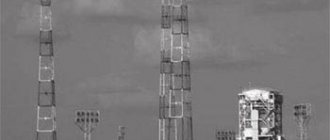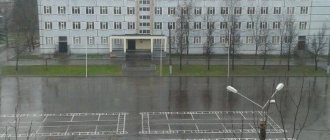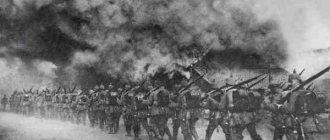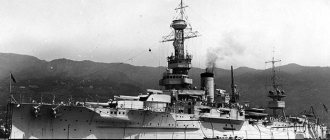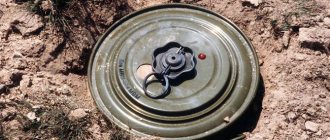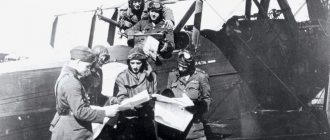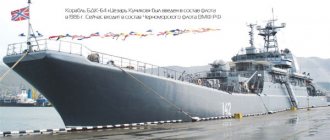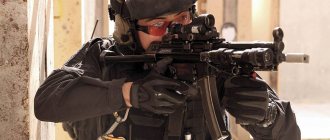History of the creation of military unit 92154
Today, all GRU special forces units are an executive body of a non-profit militarized nature. Their responsibilities include conducting reconnaissance and defensive operations.
As for the history of military unit 92154, its formation is closely connected with the work carried out by the elite branch of the Russian military - the GRU special forces. Such units first appeared in early May 1951. They were created to prevent the threat of nuclear war and contain the so-called “Cold War” between the West and the countries of the Socialist Commonwealth. At that time, 46 companies were created, each of them had 120 people.
The work of GRU special forces is classified. It is easier to obtain information about nuclear weapons developments than information that reflects the activities of special forces units. And this can be easily explained: the work of special forces is aimed at identifying military groups behind enemy lines, conducting special operations, searching for and eliminating saboteurs. Some tasks of the GRU special forces were declassified after a while, but only half, many of them are half legendary. The only thing that is truly reliable is that the military camps, which included Senezh, had a set of technical means and weapons for instant response during operations of various types of complexity.
The training of special forces was brought to a special level, was very intense and was focused on conducting individual courses for a group of several people. This idea is actively supported now in military unit 92154. If in 1953 it had 11 special forces companies, then in 1957 the military unit was replenished with 5 battalions, and in 1962 with 10 brigades.
The largest first special forces operation is considered to be its participation in the suppression of the coup in 1968 in Czechoslovakia (a country from the former socialist camp). Subsequently, GRU special forces troops were involved in operations, including combat ones, that were carried out in the countries of Latin America and Asia (Afghanistan).
With the collapse of the USSR, new points of application of the forces of individual units of the GRU special forces appeared on the territory of the country. At that time, armed clashes took place on the territory of Chechnya, Dagestan, and Georgia.
And today in In the town of Senezh, soldiers are being trained for special forces units. In the modern world, the tasks facing soldiers have changed. They not only carry out intelligence work, but also fight sabotage activities that undermine the stability of a fragile world, as well as terrorism, which is called the main problem of the 21st century.
SPECIAL FORCES
HISTORY OF THE CREATION OF SPECIAL PURPOSE TROOPS OF SOUTH AFRICA
1. The concept of special forces originated in the South African Armed Forces in the late 60s, after becoming familiar with similar US units. In 1970, an organizational group of 11 people began work under the command of Commandant J.D. Breytenbach. It was called Group Alpha or Operational Experimental Group (OEG) and was administratively subordinate to the infantry school at Oudshoorn. The group conducted research in the field of operational art and checked the level of combat readiness of Ground Forces units. During the operations carried out under the command of Major General F.V. Lutz, knowledge and experience were accumulated, which were later used in the creation of special forces units. Gradually, administrative control of the unit passed to the Southern Cape Command.
2. The first special forces unit, namely 1 Commando Reconnaissance Unit, was created on October 1, 1972 as a result of the work done by the OEG. The process of selecting and training personnel from among the military personnel of the Armed Forces, mainly from the Ground Forces, began. Shortly after the formation of the unit, it was transferred to the Fort Doppies training center in East Caprivi and was supervised by Colonel Gleason.
3. After the decision was made to expand the infantry school, a new location was required for the unit. On 1 January 1975 it was transferred to Durban, where the 1st Reconnaissance Regiment is currently stationed. By order of the same date, Commandant J. Suart was appointed commander of the unit.
4. At the end of 1974, the 2nd Commando reconnaissance detachment was formed in Johannesburg, headed by Commandant S. Van der Spuy.
5. Military personnel of the 1st and 2nd detachments supported the actions of Ground Forces units during Operation Savannah in 1975-1976. However, they did not perform any classic tasks typical of special forces units. Operation Savannah was the final stage in the creation of special forces. The problems experienced during this phase were unusual for the special nature of special forces and were not fully appreciated even by those directly associated with them.
6. The need to introduce specialization in special forces was emphasized during Operation Savannah. And on March 1, 1976, a naval unit was formed as part of the 1st Commando detachment on Salisbury Island in Durban harbor. As a result of contacts with the Rhodesian army, on the model of its reconnaissance units, the so-called “Zulu Scouts”, the following unit was created under the command of Major J.P. Verster, whose main task was to conduct decoy operations. During the same period, in Durban, an administrative and economic unit was created under the command of Major S. J. Poole for logistical support of combat units.
7. In 1976, the need arose to purchase special equipment abroad. For this purpose, a special group was created, known as the Special Supply Group, headed by T. G. Shaffer.
8. In 1977, another step was taken towards further decentralization and specialization. Specialized units were created to operate from the air, from the sea and to conduct decoy operations. A naval unit, 4 Commando, was formed at Langebaan in July 1978, and a decoy unit, 5 Commando, was formed at Dooku-Duku. The 1st Commando detachment became a specialized airmobile unit.
9. At the same time, a project was launched to determine the need for buildings and other structures. This project included a complex at Phalaborwa to accommodate the expected arrival of Rhodesian troops.
10. The year 1979 was marked by a thorough analysis of the need to organize and integrate special forces into the structure of the South African Armed Forces. The analysis was carried out by consultant S. Serfontein. Modern SN troops owe their existence to the results of this research, including the change in unit status and name from Commando Reconnaissance Detachment to Reconnaissance Regiment.
11. In 1980, at the end of the Rhodesian War, two Rhodesian units, namely the Zulu Scouts and the SAS, were incorporated into the Special Forces and formed the 3rd and 6th Reconnaissance Regiments, stationed at Phalaborwa and Durban respectively.
12. Within one year, most of the Rhodesians had left the Armed Forces and both units had to be disbanded. The remainder were distributed to other regiments.
13. After the disbandment of the 3rd regiment, the 5th reconnaissance regiment was transferred to its place. The base being built at Duku-Duku for the needs of the 5th Regiment was transferred to the Ground Forces; the forestry at Duku Duku was retained as a training center for special forces.
14. In 1982, command of the special forces was transferred from Major General Lutz to Major General Lebenberg. The period of General Lutz's command is the period during which special forces were introduced into the Armed Forces. The right to the existence of troops was not recognized by everyone, and this resulted in the lack of selection of the necessary personnel for the SN troops, which led to their slow growth. The completion of the construction project satisfied the needs of most units, which is also considered one of the most important achievements of General Lutz.
15. Major General Lebeneberg commanded the troops until November 1985. During this period, the main focus was on consolidating the combat capabilities of the SN troops. Having everything they needed, the units constantly took part in various operations. The success of these operations largely depended on the general attitude towards the SN troops.
16. During the period of General Lebenberg's command, the units confirmed their purpose. The staffing structure of the units was tested and improved, which led to a more effective implementation of their assigned tasks. The educational process was brought to the modern level during this period.
17. A new unit that became part of the SN troops was a medical detachment under the command of Commandant V. Basson. It later became the 7th Medical Battalion. Its task is to provide medical support to the SN troops and parachute brigades. Many doctors have received qualifications as soldiers of the SN troops.
18. Brigadier Huber took command of the SN troops in November 1985. Since the troops by that time were provided with everything necessary, he focused his efforts on the quality of the selection of candidates and the preparation of personnel for combat operations. As a result, a training unit was created as part of the 1st reconnaissance regiment.
19. Brigadier E. Web took over the post of commander of the SN troops from Major General Huber in December 1988. During his command, he achieved an increase in pay for military personnel of the SN troops.
20. 5th Reconnaissance Regiment became the first unit of the SN troops to receive the banner on December 5, 1988 from the hands of Brigadier Svart.
21. Like any new concept, the SN force developed slowly due to the fact that the role and requirements of the SN force were not fully understood and accepted within the Armed Forces. SN troops need support from the Armed Forces to successfully complete tasks and it can only be provided as a result of successful actions. Over the past few years, the SF troops have operated successfully and this has led to an increase in the scope of assistance from the Armed Forces.
DEFINITION OF SPECIAL FORCES
22. These are troops that carry out reconnaissance and raid operations in the tactical or strategic depth of the enemy’s defense and carry out a pre-planned withdrawal after completing the task.
TARGET
23. Destruction of bases and isolation of the enemy from sources of supply through proactive and decisive special measures.
CHARACTERISTIC
24. The goal is achieved by and with the help of:
A. Highly trained employees. b. Reliable intelligence information. V. Sources of supply. d. Non-standard thinking.
25. A special forces soldier must be a professional in the following areas:
A. Patrol actions and survival. b. Minno is a subversive business. V. Fire training. d. Individual combat skill. d. Physical fitness and endurance. e. Mental abilities. and. Flexibility.
26. He must be ready to withdraw behind enemy lines:
A. By air. b. By land. V. On water.
PRINCIPLES OF SPECIAL OPERATIONS
27. Careful planning. It is the basis of special operations and should always be given sufficient time. Those involved in planning an operation must use all possible sources of information and take into account all possible factors for better preparation.
28. Conspiracy. Must be followed throughout the planning process as well as during execution. The purpose and objectives of the operation should be known only to a narrow circle of people who are directly related to its planning and execution. Preparation for the operation should be carried out in isolation, and it must be remembered that secrecy does not stop after the operation is completed.
29. Suddenness. This is the most important principle during the operation. Planning must be based on the use of surprise. A non-standard plan helps achieve surprise. Remember the motto: “The city takes courage.” The most incredible task can be accomplished using the element of surprise even with small forces.
30. Misleading the enemy. A realistic plan must be prepared to deceive the enemy, especially for the stage of getting behind enemy lines. This helps to achieve surprise during the operation. It is necessary to make maximum use of non-standard methods of misleading the enemy, which leads to an increase in the time required for the enemy to respond, for example, you can impersonate an enemy patrol.
31. Flexibility. All actions must be based on flexibility. Therefore, it is necessary to have an alternative plan. The unit must be prepared to take appropriate action in the event of unforeseen circumstances and to deviate from the established plan if the situation requires it.
32. Logistics plan. Routine logistics and contingency support arrangements must be carefully planned. It is necessary to plan in advance for the immediate evacuation of the wounded and dead. The appropriate headquarters must ensure that all combat unit requests are met to ensure the success of the operation.
33. Rehearsals. Before the start of the operation, it is necessary to rehearse the upcoming actions in such a way that all possible situations are played out and each soldier knows his actions at each stage of the operation. Complex techniques must be practiced until they are performed clearly and correctly.
34. Statement of the problem. The task must be set in detail to all participants in the operation, including headquarters and services providing support. Each participant must know in detail the order of their actions.
35. Action plan in case of unforeseen situations. Everyone should know alternate collection points and landing sites. Actions to evade an enemy must be carefully planned and everyone must know and understand the procedure.
COMMAND AND CONTROL DURING THE OPERATION
36. Command and control is divided into 4 categories:
A. Group commander. He is responsible for the direct execution of the task by his unit. b. Squad leader. Leads two or more groups and is located in a combat area. V. Head of the operation. Responsible for the success of the entire operation and is located at the tactical level headquarters. g. Commander of the troops. Provides general leadership and is located at the headquarters of the troops.
THE ROLE OF SPECIAL FORCES IN CONVENTIONAL AND COUNTERINSURRENCE OPERATIONS.
37. Role. Special forces were created to perform tasks behind enemy lines, rather than tasks performed by conventional units.
38. Insurgency.
A. Its development goes through 4 stages:
- 1st stage. Organization.
- 2nd stage. Terrorism.
- 3rd stage. Guerrilla warfare.
- 4th stage. Mobile Operations (Conventional Warfare).
b. Tasks of the SN troops during the 1st stage.
- Surveillance of suspects.
- Kidnapping suspects.
- Gathering information about suspects.
- Infiltrating agents into troubled areas.
- Sniper operations during illegal rallies.
- Provide support and training to police and security personnel to clear buildings occupied by suspects.
V. Tasks of the SN troops during the 2nd stage.
- The same as during the 1st stage.
- Elimination of identified leaders.
- Reconnaissance and raids on confirmed enemy bases, establishments or hideouts.
- Ambushes on enemy penetration routes.
- External operations to neutralize enemy organizations and sources of their supplies.
- Destabilization operations in countries that provide support and refuge for insurgents.
d. Tasks of the SN troops during the 3rd stage.
- The same as during the 1st and 2nd stages.
39. Mobile Operations/ Routine Operations Phase. This stage can be divided into 4 different aspects:
A. Nomination. b. Offensive. V. Retreat. City Defense.
40. Promotion.
A. Tasks of the SN troops during the advance of the enemy.
- Conducting surveillance in order to determine the routes for the advance of the main forces.
- Artillery fire adjustment.
- Blocking supply routes for supplies.
- Forcing the enemy to use certain routes to advance by destroying important bridges, railways and mining roads.
- Sabotage behind enemy lines at airfields, ammunition depots, etc.
- Raid operations after withdrawal to the rear using the deployment method.
b. Tasks of the SN troops during the advance of their troops.
- Reconnaissance and confirmation of enemy locations.
- Capture prisoners to obtain information about the enemy.
- Organization of observation posts in territory occupied by the enemy to correct artillery fire.
- Detection and destruction of enemy reconnaissance equipment, such as radar.
- Disruption of enemy transportation by mining roads and carrying out acts of sabotage.
- Reconnaissance and designation of routes for the advance of friendly troops.
- Blocking possible enemy escape routes.
41. Offensive.
A. Tasks of the SN troops during the enemy offensive.
- Cutting off supply routes for supplies.
- Carrying out acts of sabotage behind enemy lines.
- Deployment of an OP behind enemy lines to control artillery fire.
- The use of false units to detect enemy headquarters and their destruction.
- Providing support to partisan formations in order to disperse enemy forces.
b. Tasks of the SN troops during the offensive of their troops.
- The latest confirmation of the location of enemy targets.
- Organization of OP for the purpose of adjusting artillery fire.
- Organizing ambushes or mining enemy escape routes.
- Destruction of infrastructure behind enemy lines.
- Disruption of enemy transportation.
- Conducting reconnaissance and designating routes and deployment areas.
42. Retreat.
A. Tasks of the SN troops during the retreat of enemy troops.
- Destruction of infrastructure behind enemy lines.
- Organization of OP for the purpose of adjusting artillery fire.
- Reconnaissance of new enemy locations.
- Disruption of enemy transportation.
b. Tasks of the SN troops during the retreat of their troops.
- Carrying out acts of sabotage and laying mines to detain the enemy.
- Disruption of enemy transportation.
- Organization of NP for artillery fire correction.
43. Defense.
A. The tasks of the SN troops during the defense of enemy troops.
- Reconnaissance of enemy positions and transportation routes.
- Reconnaissance of routes and deployment areas for friendly troops.
- Disruption of enemy transportation by mining routes and carrying out acts of sabotage.
- Sniper operations.
- Capturing prisoners.
b. The tasks of the SN troops during the conduct of defense by their troops.
- Harassing actions behind enemy lines.
- Capture prisoners to obtain information about the enemy.
- Organization of NP for artillery fire correction.
- Mining possible enemy approach routes.
- Organizing ambushes on enemy patrols.
- Sniper operations.
- "Hunt" for tanks.
CHAPTER III
Impressions from those who served in military unit 92154
Military unit 92154 is a reconnaissance battalion. It is part of the 346th separate GRU special forces brigade. The Senezh military camp is equipped with everything necessary for training and maintaining the uniform of special forces, namely: training, airborne, dog training, training and fire complexes, a platform for improving the skills of driving special equipment, service and medical institutions, and a headquarters building.
Dormitories have been built to accommodate the soldiers. Among them there are both cockpit-type and family-type ones. Each is equipped with a kitchen, a bathroom, a gym with exercise equipment and a cozy relaxation room. Officers have the right to rent housing in Solnechnogorsk.
The oath day in military unit 92154 is Saturday. It starts exactly at 09:00, so from 08:40 some relatives and close military personnel begin to be allowed into the territory. On this day, those who take the oath are given dismissal until 21:00. At night, soldiers must be in their units. On Sunday, the second day after the oath, fighters can also go on leave from 09:00-18:00. To do this, one of the relatives must leave a passport as collateral.
Soldiers serving in military unit 92154 are allowed to use mobile devices with Internet access. It is important not to violate the regime for using smartphones and other gadgets: from 19:00-21:00 exclusively on weekends.
Everyone who is sent to a military unit for service is intensively engaged in physical training. Every day they spend several hours on the obstacle course, perform forced marches, master and improve the skills of hand-to-hand (and not only) combat.
During hand-to-hand combat, a stronger and more experienced opponent is selected so that the fighter is prepared to fight any enemy. Soldiers must also be able to use available means during hand-to-hand combat. All mastered skills are tested twice a year.
The (standard) equipment of a GRU special forces soldier includes: an unloading vest with pouches, adjustable belts, and shoulder-belt systems. In addition to the unloading system, the fighters have a casual uniform, a helmet with body armor.
Soldiers of military unit 92154 receive a cash subsidy from the state, which is credited to their Sberbank card. The accrual procedure is as follows: conscript soldiers receive a subsidy once a month, contract soldiers - 2 times a month. There are no ATMs at all in the Senezh military town. To cash out funds you will have to go to the garrison, i.e. to the city of Solnechnogorsk. You can use 24-hour ATMs located:
- on Sovetskaya street, 5/15;
- on Bankovskaya street, 6;
- on Krasnaya Street, 176.
Contract service in GRU units, including military unit 92154, is possible under the following conditions:
- persons are allowed to serve upon reaching 28 years of age;
- before entering contract service they had to serve as a warrant officer or officer;
- The contract worker's education must be at least secondary;
- they must have with them letters of recommendation from their previous place of service;
- upon entering the service, they must pass standards for push-ups, pull-ups, running, etc.;
- their check should include a medical examination, a conversation with a psychologist, passing a lie detector, checking relatives for the fact/absence of a criminal record;
- relatives must give written consent for the applicant to be enrolled in special forces.
Divisions
There are several main divisions, each with its own tasks.
Marines
It is not very numerous, but without it some manipulations are impossible. The roots of the Marine Corps go back to the reign of Peter I, who established the first regiment in 1705. The selection of candidates is more strict than for the airborne troops. Special forces soldiers wear black berets.
Airborne Forces
An independent branch of the armed forces, designed to cover the enemy by air. The main method of delivery is parachute or landing. Units can also be delivered by helicopter. They are the reserve of the Supreme High Command.
Directorate "A", group "Alpha"
The main goal is to conduct urban anti-terrorist operations under the control of the Russian political leadership. It is part of the “Special Purpose Center of the FSB of the Russian Federation” and includes a headquarters, five departments, and regional divisions. One department is permanently located in Chechnya.
Directorate "B", group "Vympel"
Created in 1981, it was the most famous foreign intelligence unit of the KGB of the USSR. Today, most of the staff are people from counterintelligence. Everyone has their own specialization. It takes at least five years to train one specialist. Previously, the group was involved in infiltrating enemy territory, protecting Soviet embassies, and conducting active espionage activities. There is no information about current activities in open sources.
Riot police
In addition to the internal troops, the Ministry of Internal Affairs has special police units at its disposal. They have branches in almost all major cities. Riot police are involved in anti-terrorism activities. In their work, fighters use a wide range of weapons. Transport is represented by minibuses, trucks, and armored personnel carriers.
Note: different countries of the world have their own special forces:
- Yamama. An elite unit of the Israeli Border Police. The fighters have the highest level of shooting training.
- SAS. Special Airborne Service of the British Ground Forces. Has extensive experience in anti-guerrilla and counter-terrorism operations.
- Delta. A US unit designed to conduct covert combat operations outside the United States.
- Japanese Special Assault Team. Its work is aimed at combating terrorism and armed conflicts.
- Black wasps. A Cuban organization formed to ensure the security of the country's top leadership.
Thus, the Russian army special forces consists of a large number of units, some of which have a minimum of information. In addition, in the Russian security forces there are various troops who undergo training similar to special forces soldiers.
Information for mothers
Where to send parcels and letters
Military unit 92154 is located at the address: index 141502, Solnechnogorsk-2, Moscow region, v.g. 52/3, military unit 92154, full name of the serviceman. The Solnechnogorsk post office serving the military unit is located at the address: 141502 MO, Solnechnogorsk-2, Lesnaya St., 10. Written correspondence and parcels are issued to soldiers once a week. You can send only permitted items (their list can be checked with military personnel).
List of contact numbers:
- (4962) 63 11 02 - number of the military commandant’s office of the Solnechnogorsk garrison;
- (495) 994 06 88 - telephone number of the company duty officer, military unit 92154;
- (4962) 63 60 03 - number of the hospital’s emergency department;
- (4962) 63 67 03 - clinic number;
- +7(925) 525 78 18, taxi service in Solnechnogorsk;
- (495) 994 02 51, accommodation reservation.
How to get to the military camp "Senezh"
You can get from Moscow to Solnechnogorsk:
- By train "Klin" or "Tver", which departs from the Leningradsky station. Get off at the station. "Sunflower".
- By bus No. 440 from the station. m. "Water Stadium" to the end of the route.
- Bus route No. 31 from the stop. "Podsolnechnaya" in Solnechnogorsk to the bus stop. "Voengorodok".
